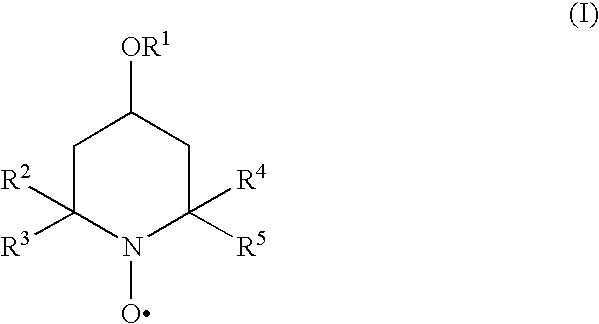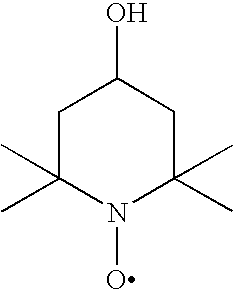Inhibition of polymerisation
a technology of polymerisation and inhibition, applied in the direction of other chemical processes, organic chemistry, chemistry apparatus and processes, etc., can solve the problems of high risk of unwanted radical polymerisation, high sensitivity of ethylenically unsaturated monomers to unwanted radical polymerisation, and generally poorly soluble water solubility in non-polar organic solvents. to achieve the effect of inhibiting the premature polymerisation of ethylenically unsaturated monomers and significantly increased
- Summary
- Abstract
- Description
- Claims
- Application Information
AI Technical Summary
Benefits of technology
Problems solved by technology
Method used
Image
Examples
example 1
[0066]The solubilities of 4-oxo-TEMPO, 4-hydroxy-TEMPO and 4-butoxy-TEMPO in water and toluene were tested by preparing saturated solutions and measuring the amounts dissolved.
[0067]The solubilities of the compounds are given in Table 1. 4-butoxy-TEMPO was found to have a greater solubility in toluene than the 4-oxo- and 4-hydroxy-TEMPO compounds.
TABLE 1Solubility inCompoundwater (% wt / wt)Solubility in toluene (% wt / wt)4-oxo-TEMPO22.5>804-hydroxy-TEMPO40~104-butoxy-TEMPO0.25miscible
example 2
[0068]The evaluation of the efficacy of a selection of nitroxide compounds of the invention was carried out using a continuous stirred tank reactor (CSTR) which mimicked the re-boiler of a styrene distillation column. The styrene had a residence time of approximately 2 hours inside the reactor and, at 110° C., the CSTR dead volume was 180 ml. A steady state was reached in four hours using a styrene flow rate of 90 ml / hr. Data gathered after this point was averaged to give the steady state polymer level. Nitrogen sparging to remove oxygen gas was carried out at a measured rate of 200 ml / minute. Apart from the inhibitors, the only variable was the inherent variation in the rate of thermal initiation of styrene polymerisation. The nitroxides tested were 4-methoxy-TEMPO, 4-hydroxy-TEMPO, TEMPO, 4-butoxy-TEMPO and 4-allyloxy-TEMPO.
[0069]The steady state polymer levels for each compound are given in Table 2. Taking into account differences in molecular weight (for example, the molecular w...
example 3
[0070]The experiment of Example 2 was repeated using combinations of 4-hydroxy-TEMPO and the other compounds.
[0071]The steady state polymer levels for each combination are given in Table 3. It is evident that the combination of 4-butoxy-TEMPO and 4-hydroxy-TEMPO was a more effective inhibitor than any of the other combinations. In addition, this combination was considerably more effective than the individual compounds as tested in Example 2.
TABLE 3Polymer levelConcentrationat steadyInhibitor(ppm)state (ppm)4-butoxy-TEMPO / 4-hydroxy-TEMPO67.7 / 7.5684-methoxy-TEMPO / 4-hydroxy-TEMPO67.7 / 7.5169TEMPO / 4-hydroxy-TEMPO67.7 / 7.52394-allyloxy-TEMPO / 4-hydroxy-TEMPO67.7 / 7.512291(at 210 mins)
PUM
| Property | Measurement | Unit |
|---|---|---|
| dead volume | aaaaa | aaaaa |
| styrene flow rate | aaaaa | aaaaa |
| hydrophilic | aaaaa | aaaaa |
Abstract
Description
Claims
Application Information
 Login to View More
Login to View More - R&D
- Intellectual Property
- Life Sciences
- Materials
- Tech Scout
- Unparalleled Data Quality
- Higher Quality Content
- 60% Fewer Hallucinations
Browse by: Latest US Patents, China's latest patents, Technical Efficacy Thesaurus, Application Domain, Technology Topic, Popular Technical Reports.
© 2025 PatSnap. All rights reserved.Legal|Privacy policy|Modern Slavery Act Transparency Statement|Sitemap|About US| Contact US: help@patsnap.com



